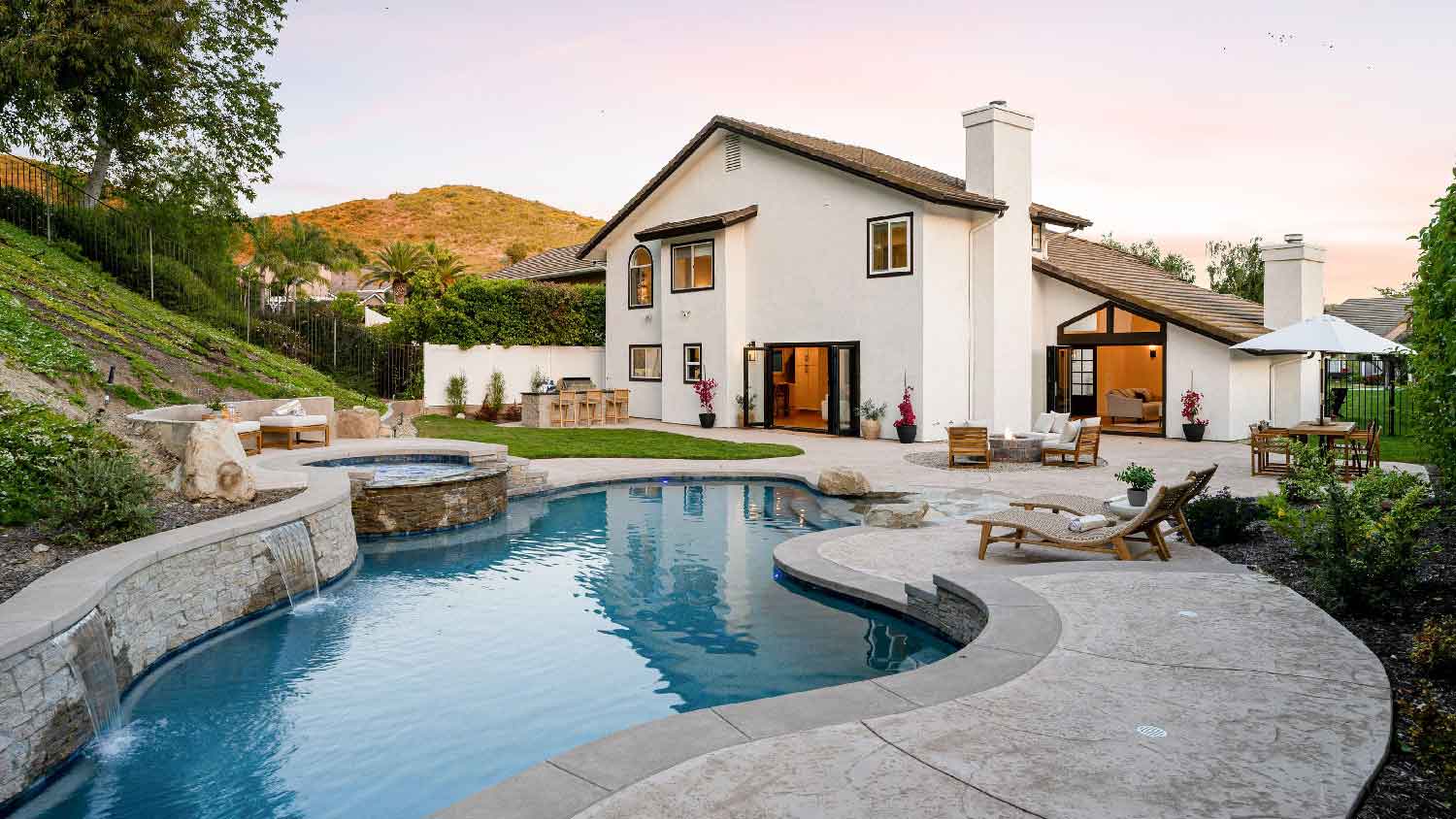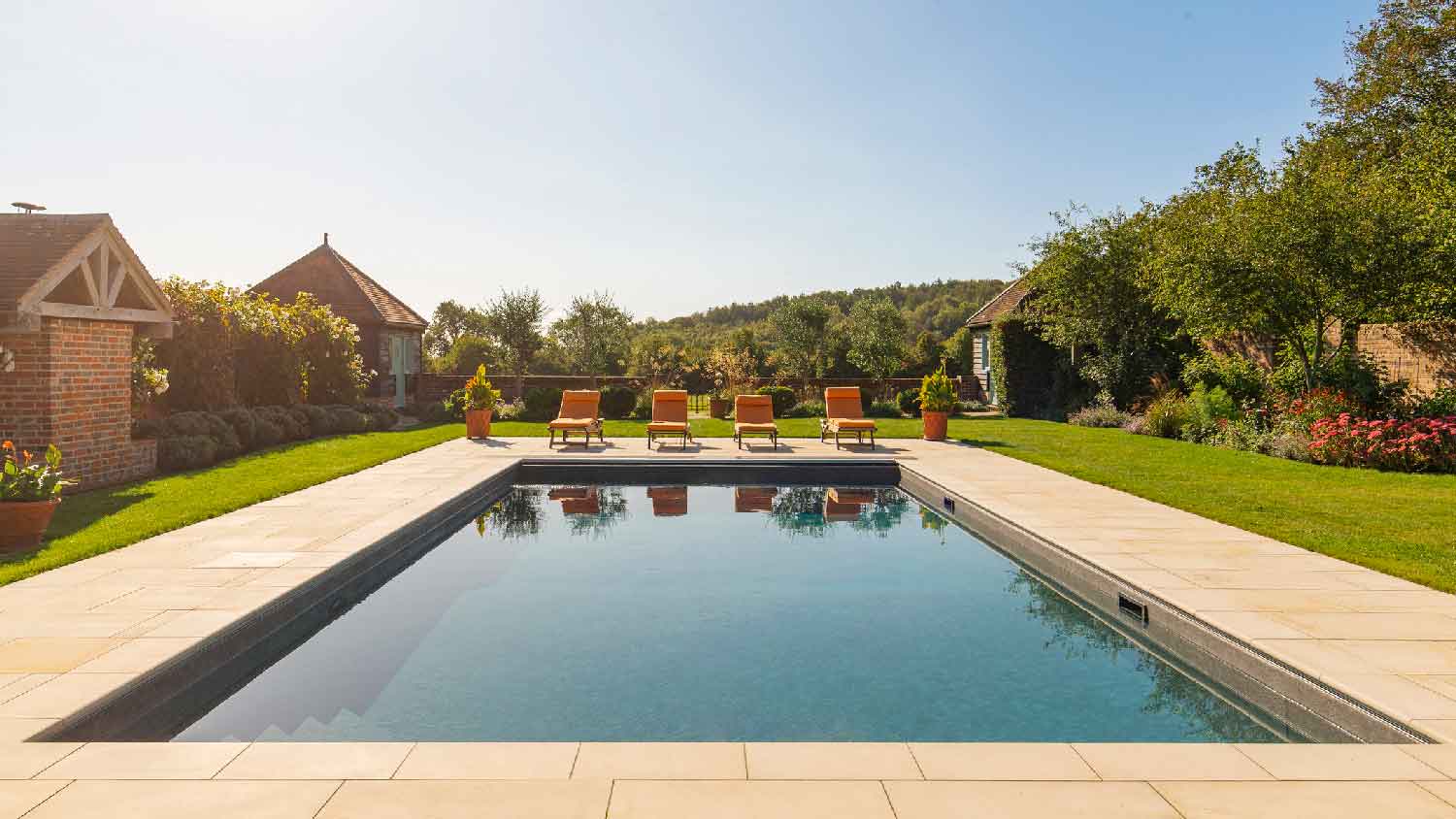7 Tips for Resurfacing Your Swimming Pool
Keep your cool with these resurfacing tips


A summer spent by the pool makes the hot and humid months more bearable. However, if your pool’s finish starts to crack and peel like a bad sunburn, you’ll need to have it resurfaced. Pool resurfacing can be a project you’d rather avoid, so follow these seven tips to help extend your pool’s lifespan and prevent excessive resurfacing projects.
1. Ensure Proper Pool Chemistry
Poor water chemistry and exposure to sunlight can damage pool finishes. One way to be on top of your pool’s finish is to buy a test kit to check the chemical levels. An unbalanced total calcium hardness level may cause damage to your pool over time, deteriorating the finish.
Keep detailed logs of the readings to stay on top of when your pool’s chemistry is off so that you can anticipate changes to the water and prevent contamination or damage to the pool.
Watch the Pool Levels
Testing your pool’s water is easy once you get in the swing of things. There are five levels that you want to regularly test for:
pH
Available chlorine
Alkalinity
Calcium hardness
Cyanuric acid levels
You can either use pool test strips or a pool testing kit to check for these levels.
Whichever option you choose, test two to three times a week, being sure to test more if you frequently use your pool or it rains.
2. Don't Ignore Pool Repairs
Take care of pool problems as soon as you notice them. Ignoring the issue will only increase costs when you finally decide to correct it. For example, damaged finishes occasionally develop leaks. If your pool has an auto-fill mechanism, the leaking water can cause erosion problems to decks and other structures, making you have to pay far more for an extensive backyard renovation than just resurfacing your pool alone.
3. Ditch the Pool Patches
When you notice a problem, patching your pool is not a sustainable option. Often, the reason why one area of the pool deteriorates is likely to affect more of the pool since you’re not taking care of the problem but are instead patching over it; if one section shows signs of deterioration, other sections will likely follow.
What’s more, is that patching doesn’t always result in a strong bond between the old and new material. If it comes off, you’re just going to have to resurface the area over and over until you bite the bullet and invest in a more durable finish option.
4. Don’t Limit Resurfacing to Off-Seasons
If you’re waiting for a lull in pool-time activities, don’t. Much like putting off inevitable repairs, waiting until the busy season passes to resurface your pool could lead to further damage. Don’t be afraid to miss out on a few days of swimming to schedule resurfacing work.
How Long Does It Take to Resurface a Pool?
Resurfacing may seem like it will take weeks or even months to complete, but a typical resurfacing project takes just five to seven days to complete.
5. Choose a Durable Finish
Plaster is the most budget-friendly finish, but it’s also the least durable resurfacing option out there. Pebble-based cement material is a popular alternative to traditional plaster, but there are other options, such as quartz- or glass-based finishes, too.
Five Types of Pool Resurfacing Finishes
Here are your options when choosing a new finish for your pool:
1. Plaster Pool Finish

Historically, plaster was the go-to finish for pools. Though plaster pools cost just $2,500 to $5,000, they only last around 10 years. If you’re hoping to make sure your resurfacing project lasts, you’ll want to opt for a more durable finish. Many durable options are aggregate finishes, though you’ll find glass tile the most durable and the costliest.
2. Quartz Pool Finish
Introducing an upgrade to conventional plaster: quartz pool aggregates consist of crushed quartz, cement, dyes, and other binding additives that give this option an edge over traditional plaster. Though quartz lasts longer than plaster, the average lifespan of a quartz aggregate is 12 years, making it the least durable choice after plaster.
Expect to pay anywhere between $3,500 to $15,000 for a quartz finish, or an average of $6,500. The biggest pool resurfacing cost factor is the size of your pool.
3. Pebble Pool Finishes
Pebble pool finishes consist of a mixture of pigmented plaster and pebbles, glass beads, stones, and seashells. Your pool will look like a speckled oasis that will have you singing songs from The Little Mermaid as you soak up the sunshine.
The pebble-based finish costs around $3,500 to $15,000 to install, depending on if you polish the finish. Pebble pool finishes are generally installed by hand with a sprayer and then polished or power-washed. The final product is naturally slip-, chemical-, and algae-resistant and can last upwards of 20 years.
4. Fiberglass Pool Finishes
Fiberglass-based resurfacing is one of the most durable options, lasting up to 30 years. Resin and fiberglass are combined to coat the surface of your pool. Your installer will add up to three coats to complete the job. Fiberglass pool finishes cost around $7,500 on average, and, like pebble finishes, fiberglass pool finishes are resistant to chemicals and algae.
5. Tile Finishes

If you want your pool to last for a lifetime, choosing tile as a finish is the way to go. Tile can come from all kinds of natural materials, including natural stone, porcelain, or glass. If you want the most durable material, opt for glass, which is nonporous, heat-resistant, and UV-resistant.
Tile comes at a cost, however; it costs around $30,000 to resurface your pool using tile. For this reason, some homeowners use tile for the waterline to prevent unsightly mineral deposits and discoloration while opting for a more cost-friendly aggregate for the rest of the pool.
6. Pick a Color You Like
Aesthetics matter when you’re on the hunt for the best pool finish for your home. Once you’ve chosen a material type, you’ll want to consider what you want in terms of color. Shade, pool depth, sun angles, and chemical balances all play a role in how your material will appear, but that’s not all that can impact the final look.
Plaster color options: Plaster tends to have a more matte appearance that is less reflective than other options. The standard go-to color is white or light-colored plaster, which is more likely to reveal stains as your pool ages. You can choose a darker-colored option to hide future imperfections, but this might go against your desired look.
Aggregate color options: Aggregate finishes are often more reflective and textured, and, therefore, easier to hide discolorations. You’ll find more color options for aggregates, too, depending on if you choose glass beads, quartz, shells, or natural stone.
Tile color options: Tile has many color options from which to choose. Pick a stunning porcelain tile, unique natural stones, or reflective glass tiles to add beauty to your pool that will make you want to spend all of your free time floating away or relaxing on the poolside.
7. Regularly Maintain Your Pool
Once the job is complete, you don’t want to risk damaging your newly resurfaced pool. One way to ensure your pool’s finish will withstand the test of time is by conducting regular pool maintenance practices. This includes:
Testing your pool’s water weekly
Skimming, vacuuming, and hand-cleaning your pool weekly
Protecting your pool during off periods by using a pool cover
Adding the right chemicals into your pool as needed
Making sure your pump is operating correctly and circulating for eight to 12 hours daily
If pool maintenance doesn’t bode well with your busy lifestyle, and regularly testing and altering your pool’s water has you feeling like a frantic laboratory scientist, hiring a pool service near you can take the burden of responsibilities off your shoulders so that you can fully enjoy your pool.





- 8 Types of Pool Finishes and How to Pick the Best One
- 10 Things to Consider When Building a Pool
- How to Design Your Dream Pool
- Pros and Cons of Filling In a Pool With Dirt
- Pros and Cons of Owning a Pool
- The Beginner’s Guide to DIY Pool Maintenance
- How To Clean an Above Ground Pool To Keep It Crystal Clear
- How to Hire a Swimming Pool Maintenance Pro
- Pool Building Timeline: How Long Does It Take to Build a Pool?
- How to Hire a Pool Contractor















